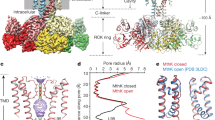Summary
α-Latrotoxin, a polypeptide neurotoxin known to cause massive release of transmitter from vertebrate nerve terminals, is thought to act by forming cation-selective channels in plasma membranes. This paper describes the steady-state current carried by Ca2+, Sr2+ and Ba2+ through pores of α-LaTx molecules incorporated in artificial bilayer membranes made of neutral lipids. Even when the solutions separated by the membrane are identical, theI-V relations rectify strongly, the current being higher when the side to which the toxin is added is positive. The polarity of the rectification is consistent with the hypothesis that the mechanism of action of the toxin is, at least in part, that of promoting inwardly directed flow of cations, and thus, accumulation of Ca2+ and other ions in the intracellular spaces. The dependence of theI-V characteristics on voltage and Ca2+ concentration is well described by a one-site, one-ion model for a channel. Three parameters of the model are deduced: the binding constant of the site for Ca2+,K=1.5m −1 (orK=7m −1 when activities are used instead of concentrations); the “electrical” distance of the site from the toxin-containing solution, α=0.3; the free energy difference between the two barrier peaks, δF =0.26 kT. The values of the parameters deduced by studying the channel in the presence of Ca2+ give theoretical curves that also fit the data with Sr2+ and Ba2+, indicating a low level of discrimination among these three cations.
Similar content being viewed by others
References
Finkelstein, A., Rubin, L.L., Tzeng, M.C. 1976. Black widow spider venom: Effect of purified toxin on lipid bilayer membranes.Science 193:1009–1011
Frontali, N., Ceccarelli, B., Gorio, A., Mauro, A., Siekewitz, P., Tzeng, M. C., Hurlbut, W.P. 1976. Purification from black widow spider venom of a protein factor causing the depletion of synaptic vesicles at neuromuscular junctions.J. Cell Biol. 68:462–479
Grasso, A. 1976. Preparation and properties of a neurotoxin purified from the venom of black widow spider (Latrodectus mactans tredecimgutatus).Biochim. Biophys. Acta 439:406–412
Grasso, A., Alema', S., Rufini, S., Senni, M.I. 1980. Black widow spider toxin-induced calcium fluxes and transmitter release in a neurosecretory cell line.Nature (London) 283:714–716
Howard, B.D., Gundersen, C.B. 1980. Effects and mechanism of polypeptide neurotoxins that act presynaptically.Annu. Rev. Pharmacol. Toxicol. 20:307–336
Kelly, R.B., Deutsch, J.W., Carlson, S.S., Wagner, J. 1979. Biochemistry of neurotransmitter release.Annu. Rev. Neurosci. 2:399–445
Krasilnikov, O.V., Ternovsky, V.I., Tashmukhamedov, B.A. 1982. Investigation of the channel formation properties of black widow venom.Biofizika. XXVII:72–75
Lassa, A. 1985. Studio delle proprieta' electtriche di membrane artificiali in presenze di neurotossine. Ph.D. Thesis. University of Genova, Italy
Läuger, P. 1973. Ion transport through pores: A rate theory analysis.Biochim. Biophys. Acta 311:423–441
Meldolesi, J., Huttner, W.B., Tsien, R.Y., Pozzan, T. 1984. Free cytoplasmic Ca2+ and neurotransmitter release: Studies on PC12 cells and synaptosomes exposed to α-Latrotoxininduced channels.Proc. Natl. Acad. Sci. USA 81:620–624
Montal, M., Mueller, P. 1972. Formation of bimolecular membranes from lipid monolayers and study of their electrical properties.Proc. Natl. Acad. Sci. USA 69:3561–3566
Robello, M., Rolandi, R., Alema', S., Grasso, A. 1984. Transbilayer orientation and voltage dependence of α-Latrotoxin-induced channels.Proc. R. Soc. London B 220:477–487
Wanke, E., Ferroni, A., Gattanini, P., Meldolesi, J. 1986. α-Latrotoxin of the black widow spider venom opens a small, non-closing cation channel.Biochem. Biophhs. Res. Commun. 134:320–325
Author information
Authors and Affiliations
Rights and permissions
About this article
Cite this article
Robello, M., Fresia, M., Maga, L. et al. Permeation of divalent cations through α-latrotoxin channels in lipid bilayers: steady-state current-voltage relationships. J. Membrain Biol. 95, 55–62 (1987). https://doi.org/10.1007/BF01869630
Received:
Revised:
Issue Date:
DOI: https://doi.org/10.1007/BF01869630




